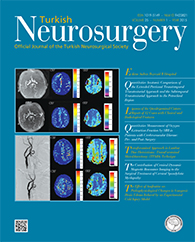2Cerrahpasa Medical Faculty, Department of Nuclear Medicine, Istanbul, Turkey
3Cerrahpasa Medical Faculty, Department of Radiology, Istanbul, Turkey
4Cerrahpasa Medical Faculty, Department of Pathology, Istanbul, Turkey
5Cerrahpasa Medical Faculty, Department of Neurosurgery, Istanbul, Turkey DOI : 10.5137/1019-5149.JTN.9752-13.1 AIM: Surgery is a treatment option for medically intractable epilepsy patients. Abnormalities in regional cerebral glucose metabolism, as identified by 18-fluorodeoxyglucose positron emission tomography (FDG-PET) have predictive prognostic value in evaluating the outcome of epilepsy surgery. This study investigated the efficacy of FDG-PET for delineation of the epileptogenic zone (EZ) by comparing its consistency with other diagnostic tools and surgical outcome.
MATERIAL and METHODS: We analyzed the results of 121 consecutive patients evaluated for epilepsy surgery. FDG-PET results were crosschecked with magnetic resonance imaging (MRI) and electroencephalography (EEG) results, as well as postoperative outcome and pathology.
RESULTS: FDG-PET findings of 75 patients (62 %) were concordant with MRI (Mc-Nemar-χ2 test p=0.024, Kappa=0.22). Further, the PET findings were consistent with EEG, and was statistically significant, according to Post-hoc test, in temporal epilepsy (TLE) group (χ2=8.21 P=0.04). Both investigations revealed localizing information in 56 (46.2%) patients. Twenty-six (72.2%) MRI-negative patients had hypometabolism on PET. The pathology of the 10 PET-negative patients was 5 cases of mesial temporal sclerosis, 2 cortical dysplasia, 2 gliosis and one tumor. Seven (70%) of these patients’ lesions originated from the temporal lobe. FDG-PET had correctly predicted the EZ in 37 (86%) of 43 patients who underwent surgery.
CONCLUSION: FDG-PET results may not be strongly associated with EZ but represent an additional tool in delineation of EZ during the noninvasive phase of presurgical evaluation.
Keywords : Intractable epilepsy, Positron emission tomography, Surgery, Prognosis




